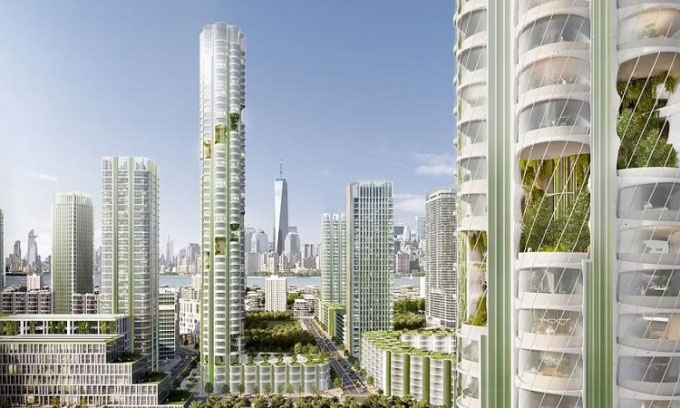Skyscrapers can absorb 1,000 tons of CO2 per year
The designers introduced a skyscraper model called "Urban Sequoias" capable of removing the equivalent of 48,500 trees of carbon from the atmosphere.
Named after the world's tallest tree, the new design is the product of Chicago-based architecture firm Skidmore, Owings & Merrill , building on existing technologies. Each skyscraper will apply a variety of techniques to capture carbon, including building with carbon-absorbing materials, growing trees and algae (for fuel, energy and food) and direct-air intake technology. next. The "stacking effect" from the design helps draw air into the center of the building to filter carbon.

The design of the carbon-absorbing skyscraper Urban Sequoias. (Photo: Skidmore, Owings & Merrill)
With a lifespan of at least 60 years, the Urban Sequoia can absorb four times as much carbon released into the atmosphere as the carbon generated by construction , the design firm says . The resulting carbon can be used to produce biomaterials for roads, sidewalks, pipelines, etc. to develop urban infrastructure.
While the prototype design was for a skyscraper that collects 1,000 tons of carbon annually, the carbon capture methods it uses can be applied to buildings of all shapes and sizes. Construction materials such as bio-brick, bio-concrete, synthetic concrete from hemp and wood help reduce 50% of the carbon generated by the construction process compared to using conventional concrete and steel.
According to Skidmore, Owings & Merrill of Chicago, the amount of carbon captured per square kilometer would be up to 120 tons if urban landscapes were transformed into gardens, rebuilt cities in the form of carbon sequestration buildings and decorated streets. added carbon suction technology. This number can increase nearly 3 times if applied in parks and many other green spaces.
Urban Sequoia is a very ambitious project and is unlikely to become a reality in the near future. Experts estimate the world's construction accounts for nearly 40% of global carbon emissions. They called on the construction industry to solve the problem. As a result, wooden buildings are becoming increasingly popular, providing a sustainable alternative to concrete. The Urban Sequoia design was introduced by Skidmore, Owings & Merrill at the United Nations COP26 climate change summit on 11/11.
- Each year, 85 thousand tons of grease, chemicals and metals are released into the sea
- The trend of building wooden skyscrapers
- The skyscrapers of the future
- Skyscrapers can fold and move like playing origami will save this world
- More than 6 million tons of garbage are thrown into the sea every year
- Earth inspires' 40,000 tons of cosmic dust every year
- Successfully developed compounds that absorb CO2 faster than trees
- Unique tree-shaped skyscrapers
- Skyscrapers take people around the world for 24 hours
- Korea race to build skyscrapers with the world
- Every year, 27 million tons of sand and dust fly from the Sahara to Amazon
- 10 super abilities of the human body
 Norway built the world's tallest wooden tower
Norway built the world's tallest wooden tower Kremlin
Kremlin Ashurbanipal: The oldest royal library in the world
Ashurbanipal: The oldest royal library in the world Decoding the thousand-year construction of Qin Shihuang shocked the world
Decoding the thousand-year construction of Qin Shihuang shocked the world